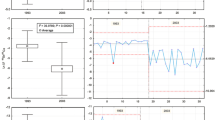Abstract
In the past, Shallow Land Burial (SLB) was considered one suitable solution for the management of fusion activated waste, the other being Recycling. These concepts have influenced the development of low activation materials for fusion (LAMs), having reduced long-term radioactivity. Present European studies, however, do not consider SLB a viable option and concentrate more on Geological Disposal (GD). A classification of activated materials into High-, Medium-, and Low-Level Waste is proposed, taking into account contact dose rates and decay heat levels, in compliance with the GD and Recycling alternatives. This proposal is also consistent with integral criteria to classify LAMs, based on both the short- and long-term radioactive behavior. Applications of these rating criteria to activated components from various fusion designs are shown.
Similar content being viewed by others
References
Final Environmental Impact Statement. NUREG-0945, U.S. Regulatory Commission (Nov.1982).
J. S. Herring, S. Fetter. Radioactive waste management criteria in fusion reactor materials selection.J. Nucl. Mater. 155–157 (1988) 597.
G. J. Butterworth. Low activation structural materials for fusion.Fus. Eng. Des. 11 (1989) 231.
C. R. Gomeret al. The feasibility of recycling activated steels first wall/blanket materials from fusion reactors.Fus. Eng. Des. 11 (1990) 423.
M. Merola, M. Zucchetti. The design of low-activation steels for a fusion reactor first wall: A proposal for a new austenitic alloy.Fus. Technol. 21 (1992) 129.
D. G. Doran. Toward improved guidelines for reduced activation materials development in the U.S.J. Nucl. Mater. 191–194 (1992) 1439.
M. Zucchetti. Impurity concentration limits and activation in fusion reactor structural materials.Fusion Technol. 19 (1991) 294.
P. Rocco, H. Scholz, M. Zucchetti. Silicon carbide and the new low-activation requirements for a fusion reactor first wall.J. Nucl. Mater. 191–194 (1992) 1474.
W. Guldenet al. Waste Management for NET. Proc. 15th Symp. On Fus. Technol (SOFT 88), p.1763, Elsevier Science Publish. (1989).
K. R. Smith, G. J. Butterworth. The Radiological Impact of Fusion Waste Disposal. IAEA Technical Meeting on Fusion Reactor Safety, Jackson (USA), April 1989.
J. P. Davis, G. M. Smith. Radiological Aspects of the Management of Solid Waste from the Operation of DT Fusion Reactors. NRPB-R210 (1987).
C. Ponti. Disposal of Radioactive Waste in Europe: Norms and Practice. T.N.I.89.08, Comm. Eur. Commun., JRC Ispra (1989).
G. Olssonet al. Quantification and disposal of radioactive waste from ITER operation.Fus. Eng. Des. 17 (1991) 415.
I. Aggerydet al. Quantification and Final Disposal of Radioactive Waste from ITER Operation and Decommissioning. Proc. 17th Symp. on Fus. Technol. (SOFT 92), to appear.
Radioactive Substances Act. H.M.S.O., U.K. (1960).
M. G. Sowerby, R. A. Forrest. A Study of the Environmental Impact of Fusion. AERE-R-13708, Harwell Report, March 1990.
Standardization of Radioactive Waste Categories. IAEA Technical Reports Series No. 101 (1970).
P. Rocco and M. Zucchetti. Criteria for Defining Low Activation Materials in Fusion Reactor Applications.Fus. Eng. Des. 15 (1992) 235.
B. Coppi, M. Nassi, L. Sugiyama. Engineering characteristics of the IGNITOR ULT experiment.Fus. Technol. 21 (1992) 1607.
C. Ponti, S. Stramaccia. ANITA Analysis of Neutron Induced Transmutation and Activation. EUR-12622 EN, Eur. Atom. En. Commun. (1989).
C. Ponti, P. Rocco, M. Zucchetti. The Analysis of Neutron-Induced Activation and Transmutation in Nuclear Materials.Materials Science Forum 97–99 (1992) 763.
J. Kopecky, H. Gruppelaaret al. Development of a European Activation File by Extending and Updating the REAC-ECN Data File. ECN-89-75, Neth.En.Res.Found. (1989).
M. Zucchetti, B. Coppi. Neutron induced radioactivity in a compact ignition experiment.Fus. Technol. 21 (1992) 2017.
ITER Concept Definition. ITER Documentation Series No.3, IAEA, Vienna (1991).
P. Rocco, M. Zucchetti. Activation Calculations for ITER with the NET Shielding Blanket. T.N.I.92.32, Comm.Eur. Commun., JRC Ispra (1992).
W. Daenner. Neutron Flux Calculations for ITER. Private communication, JRC Ispra, July 1990, April 1992.
I. Aggerydet al. Management and Final Disposal of NET/ITER Radioactive Waste. Studsvik Radwaste (Sweden), Report NW-92/33 (1992).
I. Aggerydet al. NET/ITER Radioactive Waste Fluxes for the Operational Phases and Decommissioning. Studsvik Radwaste (Sweden), Report NW-92/32 (1992).
J. W. Smith and G. V. Cole. Decommissioning and Waste Management in NET. AEA Fusion Report, AEA-FUS 283, Culham (GB), 1992.
W. Guldenet al. Fusion Waste Management. NET Report, EUR-FU/XII-80/89-92 (1989).
R. Manning. Management of NET Structural Wastes. AEA Fusion Report, AEA-FUS 111, Culham (GB), 1991.
U. Colomboet al. Recommendations of the fusion evaluation board.Energia Nucleare 4 (1990) 6.
P. I. H. Cooke, R. Hancox, W. R. Spears. A Reference Tokamak Reactor, Culham Laboratory Report. CUL-R298 (1990).
Author information
Authors and Affiliations
Rights and permissions
About this article
Cite this article
Rocco, P., Zucchetti, M. Rating criteria for activated waste from fusion reactors. J Fusion Energ 12, 201–207 (1993). https://doi.org/10.1007/BF01059379
Issue Date:
DOI: https://doi.org/10.1007/BF01059379




